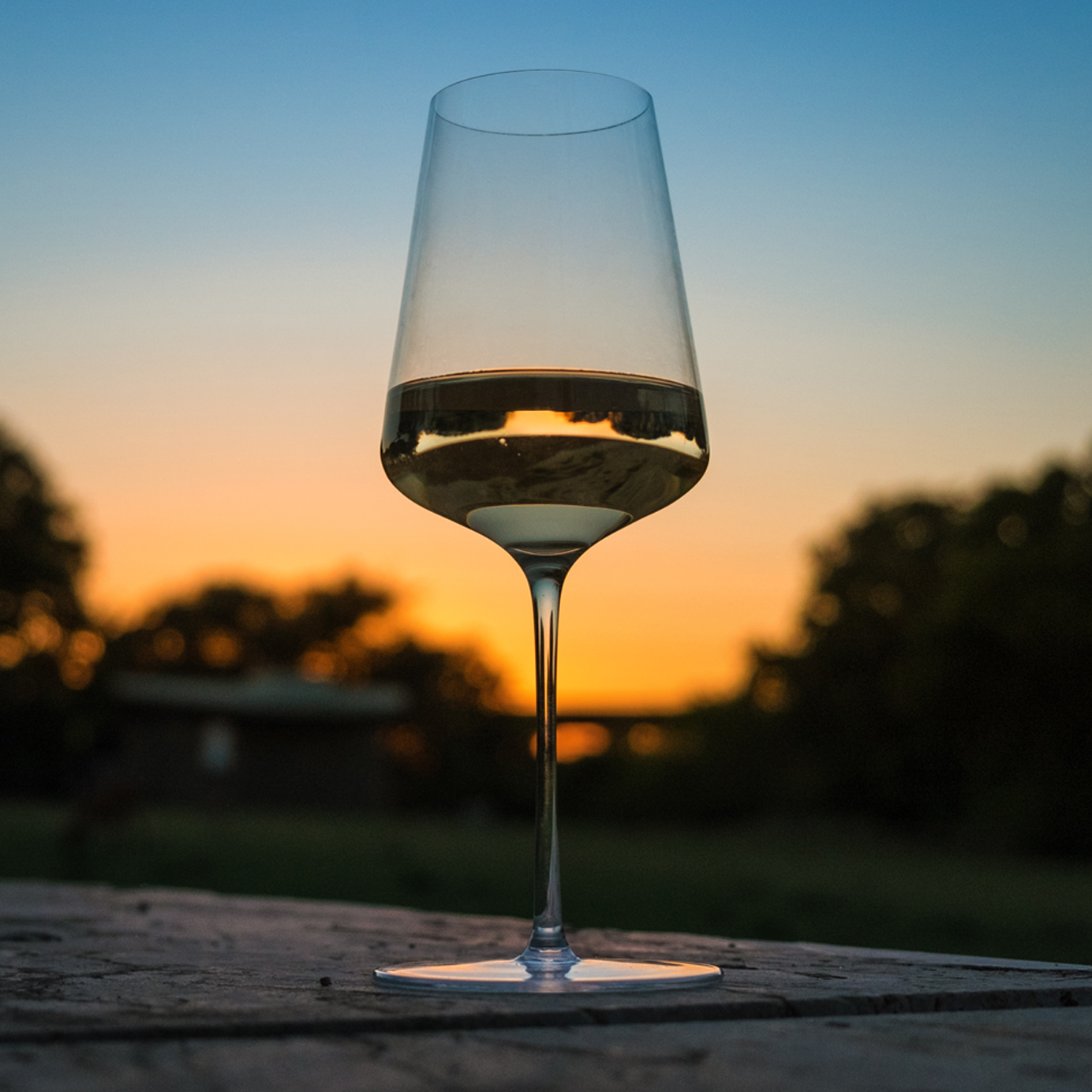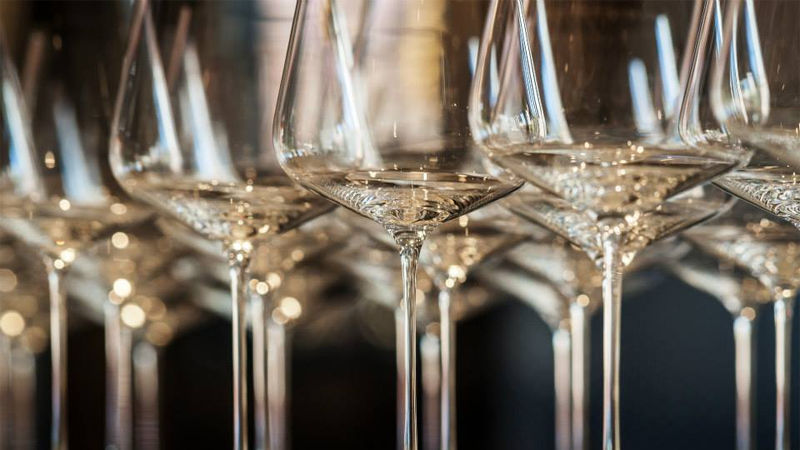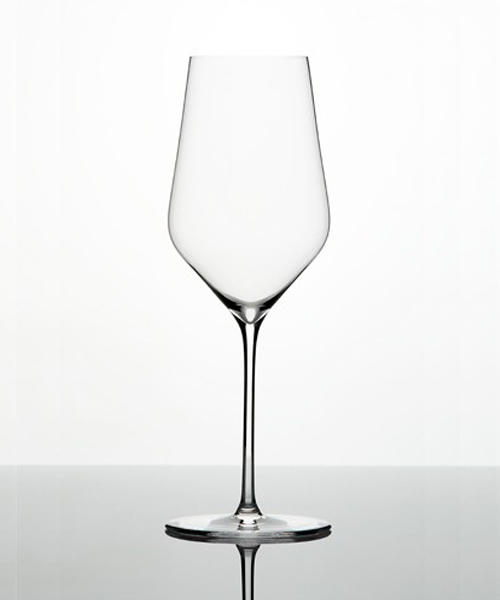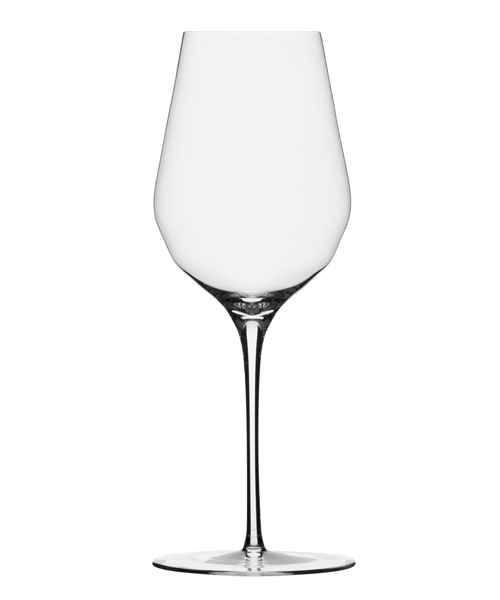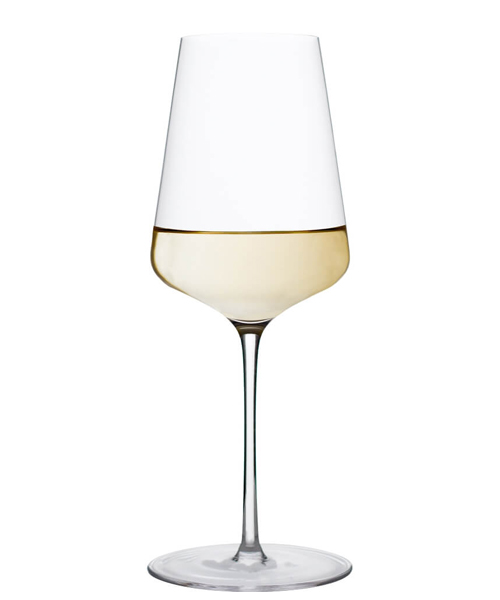Last month, the managing partner and wine director of La Compagnie des Vins Surnaturels, arguably the hottest industry hangout in NYC, hosted an invite-only launch party. It wasn’t for a new wine import. It was to celebrate a line of glassware from an under-the-radar Austrian label, MarkThomas. Attendees were greeted at the door with a glass of Krug “Grand Cuvée,” and encouraged to bring their own bottles to try out MarkThomas’s Double Bend glassware series, sans corkage fee.
“I have zero stake in these glasses or this business,” La Compagnie’s Caleb Ganzer wrote in his email invitation. “I just think they’re sick stems.”
MarkThomas’s Double Bend glasses are the latest in a wave of high-end, hand-blown Austrian glassware to bowl over U.S. sommeliers and wine lovers alike. Led by the somm-darling Zalto glasses, which gained traction in the U.S. market around 2010, wine experts are now staunch devotees of Zalto, MarkThomas, and Sophienwald.
Despite the cost of routine breakage, many of the country’s best restaurants are hardly batting an eye at these $50-to-$60- per-stem price tags. Charlie Bird, Pasquale Jones, and Aldo Sohm Wine Bar in New York City now exclusively use Zalto glasses. Matt Stamp, MS, uses Sophienwald at his brand-new Napa wine bar and retail shop, Compline. MartkThomas glassware is used at several Chicago restaurants, and at craft brewery Moody Tongue.
Other restaurants have a few Zalto sets on hand for VIP guests or super-expensive wines, giving diners a special sense of glee when the fragile, toothpick-thin stems land at their tables.
“It’s just a joy to hold it in your hand,” Aldo Sohm, wine director of Le Bernadin and Aldo Sohm Wine Bar, says of Zalto glassware. Sohm is currently a brand ambassador for Zalto.
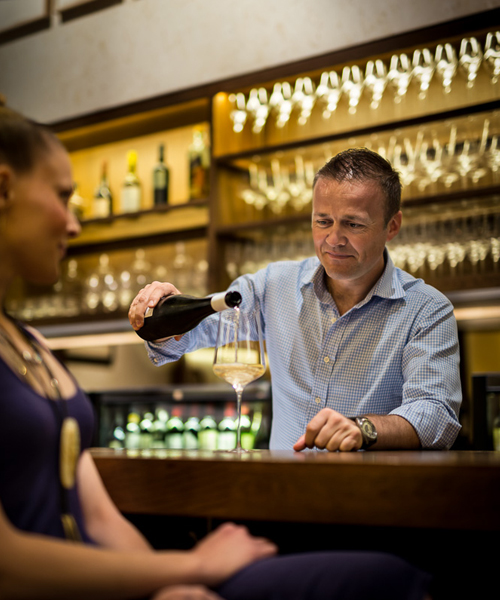
These high-end glasses, particularly from Zalto and Sophienwald, have noticeably sharp angles. The dramatic-yet-fluid curve at the base of the bowl allows wine to spread in a thin pool along the glass. Sommeliers praise these glasses’ airy weightlessness, the delicacy of the stem and lip, and the well-balanced feeling as the wine swirls in the bowl.
The design of Zalto, MarkThomas, and Sophienwald glasses affects more than aesthetics. Aromas collect in the glasses’ angles, which have the largest surface area and oxygen contact. The fluid, slightly angled walls direct those aromas to the nose, magnifying the scent. Since researchers believe that smell is 80 percent of taste, this affects the experience of wine on the palate as well.
Sommeliers have conducted side-by-side comparisons of Zalto, MarkThomas, and Sophienwald with standard restaurant glassware brands, like Riedel or Spiegelau, which retail for about $10 per glass. Many noticed a remarkable difference in the tasting experience. Ganzer remembers the first wine that he compared between standard and MarkThomas glassware, a Hofgut Falkenstein Riesling Sekt from the Mosel.
“It didn’t necessarily speak to me in a particular way out of a regular glass,” Ganzer says. “But I literally had one sniff out of the MarkThomas glass, and it was a very pure, beautiful, mineral expression.”
“We are talking nuances, but somebody who understands wine will definitely notice them,” Simon Katzenschlager, co-owner of Sophienwald distributor Adelion, says.
“I’ve always liked the term, ‘form plus flair follows function,’ in design,” Kevin Hielscher says. Hielscher owns Raaven Hill, LLC, the exclusive U.S. importer for MarkThomas. He lived in Vienna for 25 years. In Austria, Hielscher says, “you just expect well-made stemware, even at the local family gasthaus, as an integral part of your daily culinary experience.”
Austria’s glassblowing history dates back to the 13th century, after some of Murano’s famed glassblowers relocated to what is now Austria. Riedel, arguably the world’s most famous glass producer, was founded in the Austro-Hungarian empire in the 1750s.
To a certain degree, enthusiasm for these hand-blown, artisanal glasses mirrors the way many wine experts prioritize small-production, hands-to-earth wine production.
“The handmade craftsmanship cannot compare to a large production brand,” Sohm says of Zalto. “It takes seven people about seven minutes to produce one glass.”
Because Zalto, Sophienwald, and MarkThomas glasses are made by hand instead of by machine, they have paper-thin walls not possible in machine production. It sounds granular, but the thinness of glassware walls is a noticeable part of drinking. Rather than dribbling wine over a thick lip to the front of the mouth, these glasses bring wine directly to the tongue’s taste receptors. MarkThomas’ glasses are .6 millimeter thick, polished by hand to a near-point, whereas commercial glassware has a thicker, flat lip.
In the end, are these high-end glasses worth the price? For a sommelier or serious wine enthusiast, a hand-crafted glass merits the investment in the same way that an $80 bottle of grower Champagne justifies its price tag over a $10 bottle of generic, mass-produced sparkler.
“Think of it as a speaker for music,” Sohm explains. “Listening to the same song on an old speaker versus a brand new speaker is a different experience.”
The highest-quality glass will not change the taste of grocery-store juice. But for those with killer bottles in their collections, artisanal glassware might be a logical next step.
“At the end of the day, it’s not a necessity of life, but it is a nice addition,” Ganzer says. “Yes, it is more expensive, but if people are having a better time, I want to be able to provide that.” Like beauty, good taste is in the eye (or hand) of the beholder.
Get to Know Your Glassware
Zalto
First imported into the U.S. in 2005 after wine importer Stephan Schindler discovered them while visiting Austrian wineries, Zalto was the first of these glasses to take hold among American sommeliers. The Zalto Denk’Art series is used for top wines and guests at high-end establishments like the French Laundry, Per Se, and Eleven Madison Park, among many others, known for its thinness and dramatic design.
Zalto is perhaps the standard-bearer when it comes to angles, taking a cosmic approach to the design of its signature Denk’Art series, a parallel to biodynamics in winemaking. The curve of the bowl tilts in accordance with the tilt angles of the earth (24°, 48°, and 72°), an ancient Roman triumvirate used to keep produce fresh for longer periods of time. The low-lying curve is definite but fluid, far more angular than the average wine glass.
Zalto glasses contain no lead oxide, eliminating clouding over time, and are surprisingly dishwasher-safe. They are available across the U.S. and online. Average price: $60.
MarkThomas
Founded by Thomas Zichtl in 2012, MarkThomas has the most distinct design differentiation from its Austrian comrades. Rather than a single sharp angle at the base of the glass, MarkThomas’ hand-blown Double Bend Allround series has two distinct angles.
From a practical standpoint, the two bends signify two easily measurable, ideal wine pours: The first bend will give drinkers a 2-ounce tasting pour, whereas the second bend will create a standard 6-ounce glass. The second bend is also the widest point of the glass, where the wine has the greatest surface area contact with the air. Like Zalto glasses, they contain no lead oxide and are dishwasher safe.
Hielscher, who created his company to import MarkThomas in 2014, primarily distributes the glassware in Chicago.
The glasses are available in limited quantities from Chicago home store Kneen & Co. Average price: $70.
Sophienwald
While they look similar to Zalto glasses, Sophienwald’s Phoenix series has an even more dramatically angled curve at the bottom of the bowl, with fluid lines leading to the nose. Sommeliers praise its durability as much as its style, possibly making these the most dishwasher-friendly of all. They will not cloud over time.
Sophienwald glassware is used at select restaurants and bars, including Compline in Napa and several McGuire Moorman restaurants in Austin, and they are available for purchase online. Average price: $50.
